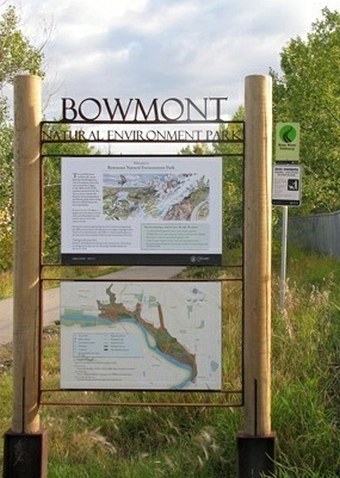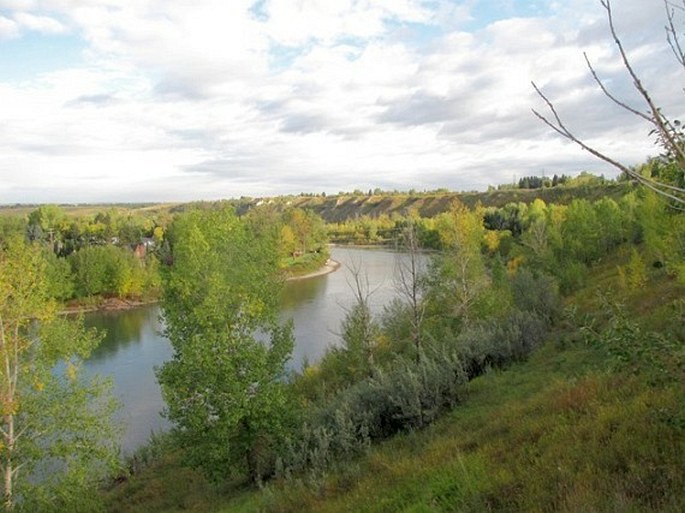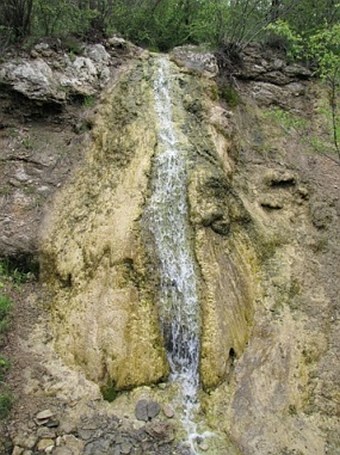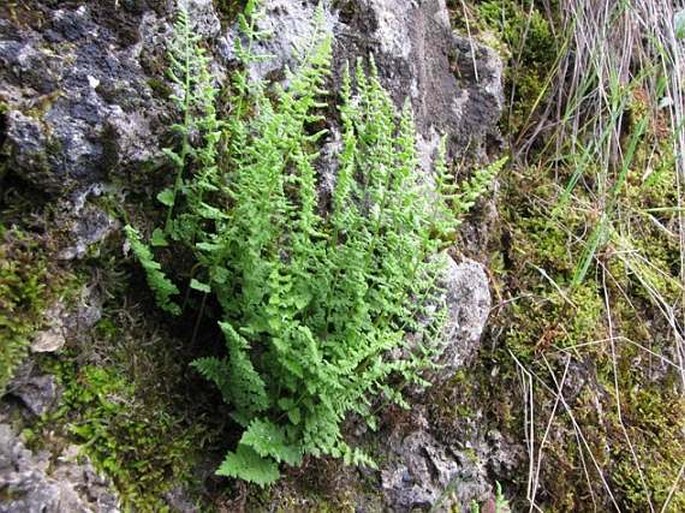Bowmont Park is located on northern banks of Bow River in western part of the City of Calgary. It was designated as city park in 1975.


It is a long noodle about 4 km long and at its widest about 400 m wide. There are three access points, one at each end and one in the middle, to get to one of its 3 narrow coulees; this one called Waterfall Valley. The park, due to its varied habitats, on its 164 ha area, is a welcome target of different naturalist interests. Birders are here all the time as birds have lots trees and shrubs not only during migration times but during the breeding times as well. Botany enthusiasts can enjoy wildflowers during the whole growing season, which is due to our climate, quite short. You can explore wonders of nature from the top of the escarpment, which 30 m above the river, through both shallow and deep ravines, right to the water’s edge.
Not all of the park is totally in natural state, as in one area the land was used for agriculture and another as a commercial gravel pit and concrete plant. Both of these areas are presently being reclaimed. Due to its location only two habitats can be investigated. Aquatic and riparian.

Fast moving waters of Bow river with gravel bars and small islands, banks of the river, host variety of ducks and other water fowl and Osprey (Pandion haliaetus) is hunting here for fish. In the upper reaches, getting into the coulees and grassland we can find stands of Quaking Aspen (Populus tremuloides), in wetter parts Balsam Poplar (Populus balsamifera) and shrubby Water Birch (Betula occidentalis). As far as shrubs are concerned, the most common are Red-osier Dogwood (Cornus sericea), Canada Buffaloberry (Shepherdia canadensis), Saskatoon Serviceberry (Amelanchier alnifolia), Choke Cherry (Prunus virginiana) and Buckbrush (Symphoricarpos occidentalis). In the grass of the upper plateau you can find even Yellow Lady’s-slipper Orchid (Cypripedium parviflorum).


The richest area botanically is the Waterfall Valley which is actually one of the deepest coulees in the park. You can walk its length from the Silver Springs subdivision residential area right to the river. Close to the river and cliffs above it you can see exposed formation of sandstone bedrock (Porcupine Hills Formation), which deflects the water from the above flatlands into open waterfalls. This water on the way here dissolves calcium carbonate from the glacial deposits and deposits it on vertical surface of the waterfall and below, on top of algae, as spongy-looking stone called tufa. The activity of this formation is dictated by annual precipitation.
On this tufa rock you can find Fragile Fern (Cystopteris fragilis) and Golden Corydalis (Corydalis aurea) and of course a variety of mosses. A narrow creek is flowing through the coulee and that is where the goodies are. Long-bract Green Orchid (Coeloglossum viride), Striped Coralroot (Corallorhiza striata), and abundant Early Coralroot (Corallorhiza trifida).

On the inaccessible cliffs above the river Double Bladderpod (Physaria didymocarpa) is hanging on and to your surprise, higher on the cliffs, thrive as small shrubs Pin Cherries (Prunus pensylvanica) which are not common in Calgary area at all, due to our alkaline soil. Right at the top of the escarpment you can see a white form of Northern Sweetvetch (Hedysarum boreale) and fields of Starflower Solomon’s-seal (Maianthemum stellatum). Sun exposed bare slopes are adorned in the spring with our beautiful Smooth Blue Beardtongue (Penstemon nitidus).

Unfortunatelly, invasive species are bad even here. Especially Tartarian Honeysuckle (Lonicera tatarica), Lesser Burdock (Arctium minus) and the most horrible pest in eastern part of the park, Siberian Pea Shrub (Caragana arborescens) and its dwarf form nana.

Sampler of plants at Bowmont Park:
Actaea rubra – Red baneberry
Allium textile – Prairie Onion
Amelanchier alnifolia – Saskatoon Serviceberry
Antennaria parviflora – Small-leaved Pussytoes
Arabis divaricata – Rockcress
Arctostaphylos uva-ursi – Common Bearberry
Astragalus aboriginum – Indian Milkvetch
Astragalus agrestis – Purple Milkvetch
Astragalus crassicarpus – Groundplum Milkvetch
Astragalus missouriensis – Missouri Milkvetch
Betula occidentalis – Water Birch
Boechera holboellii – Reflexed Rockcress
Carex filifolia – Thread-leaved Sedge
Cerastium arvense – Field Chickweed
Comandra umbellata – Bastard Toad-flax
Corallorhiza striata – Striped Coralroot
Corallorhiza trifida – Early Coralroot
Cornus sericea – Red-osier Dogwood
Corydalis aurea – Golden Corydalis
Cotoneaster acutifolia – Peking Cotoneaster
Cypripedium parviflorum – Yellow Lady’s-slipper
Elaeagnus commutata – Silverberry
Erucastrum gallicum – Dogmustard
Galium boreale – Northern Bedstraw
Geum triflorum – Three-flowered Avens
Hedysarum alpinum – Alpine Sweetvetch
Hedysarum boreale – Northern Hedysarum
Linaria vulgaris – Yellow Toad-flax
Linum lewisii – Prairie Flax
Lithospermum incisum – Narrow-leaved Stoneseed
Lithospermum ruderale – Woolly Gromwell
Lonicera tatarica – Tartarian Honeysuckle
Maianthemum stellatum – Starflower Solomon’s-seal
Musineon divaricatum – Leafy Musineon
Oxytropis sericea – Early Yellow Locoweed
Penstemon nitidus – Smooth Blue Beardtongue
Phlox hoodii – Hood’s Phlox
Physaria didymocarpa – Double Bladderpod
Potentilla anserina – Silverweed
Potentilla concinna – Early Cinquefoil
Potentilla fruticosa – Shrubby Cinquefoil
Prosartes trachycarpa – Fairybells
Prunus virginiana – Chokecherry
Pulsatilla patens subsp. multifida – Prairie Crocus
Ribes oxyacanthoides – Canada Gooseberry
Shepherdia canadensis – Canadian Buffaloberry
Thalictrum venulosum – Veiny Meadowrue
Thermopsis rhombifolia – Golden Bean
Thlaspi arvense – Stinkweed
Townsendia hookeri – Hooker’s Townsendia
Viola adunca – Early blue Violet
Zigadenus elegans – Mountain Death Camas
Zizia aptera – Heart-leaved Alexander



